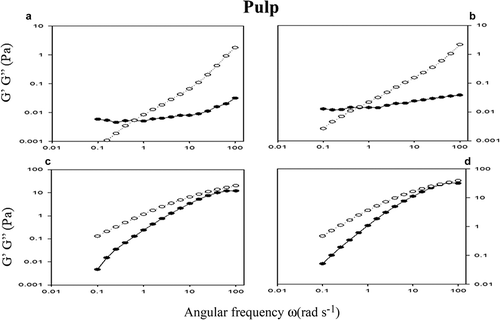Figures & data
Table 1. Chemical analysis of the hydrocolloids extracted from seed and pulp of the fruit of Hymenaea courbaril L.
Tabla 1. Análisis químico de hidrocoloides extraídos de semilla y pulpa del fruto de Hymenaea courbaril L.
Figure 1. Effect of temperature on the solubility of the pulp hydrocolloid (■), seed (▲) and guar gum (∆) at the concentration of 1%. The results represent the mean ± standard deviation of three determinations followed by the same letters do not differ by the Tukey test (p > 0.05).
Figura 1. Efecto de la temperatura sobre la solubilidad del hidrocoloide de pulpa (■), semilla (▲) y goma guar (∆) a la concentración de 1%. Los resultados representan la media ± desviación estándar de tres determinaciones. Valores con la misma letra no son diferentes estadísticamente de acuerdo a la prueba de Tukey (p > 0.05).
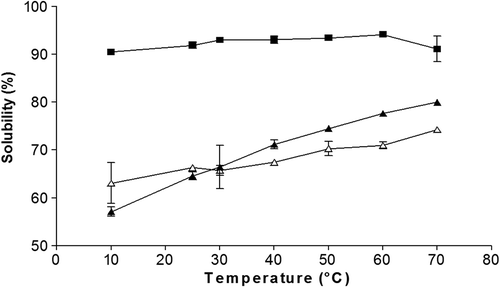
Figure 2. Emulsifying capacity (EC %) of the pulp hydrocolloid (■), seed (▲) and Guar gum (∆) used as control. The results represent the mean ± standard deviation of three determinations.
Figura 2. Capacidad emulsificante (EC %) del hidrocoloide de pulpa (■), semilla (▲) y goma guar (∆) usada como control. Los resultados representan la media ± desviación estándar de tres determinaciones.
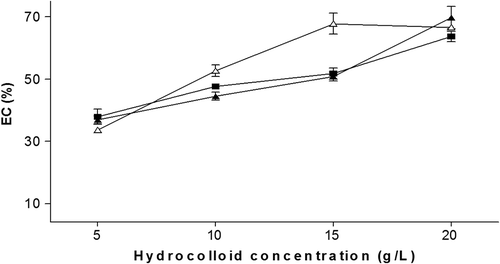
Figure 3. Volume of the creamed layer for 1 (a and c) and 2% (b and d) emulsions O/W stabilized by pulp hydrocolloid (■), seed hydrocolloid (▲) and guar gum (∆) stored at 35 and 40°C for 15 days. The results represent the mean ± standard deviation of three determinations.
Figura 3. Volumen de la capa de cremado de las emulsiones O/W estabilizadas con hidrocoloide de pulpa (■), semilla (▲) y goma guar (∆) a concentraciones de 1% (a y c) y 2% (b y d) almacenados a 35 y 40°C durante 15 días. Los resultados representan la media ± desviación estándar de tres determinaciones.
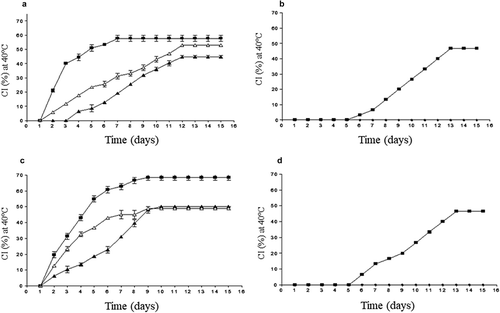
Figure 4. Optical micrographs at 40X of emulsions O/W stabilized with hydrocolloid pulp (a), seed (b) and guar gum (c) at 1–2%, stored at 35 and 40°C for 15 days. The scale of the bar corresponds to 100 µm.
Figura 4. Micrografías ópticas de emulsiones O/W a 40X estabilizadas con hidrocoloides de pulpa (a), semillas (b) y goma guar (c) a 1–2%, almacenadas a 35 y 40°C durante 15 días. La escala de la barra corresponde 100 µm.

Table 2. Maximum velocity of glucose diffusion in glucose-hidrocolloid system.
Tabla 2. Máxima velocidad de difusión de glucosa en un sistema glucosa-hidrocoloide.
Figure 5. Effect of pulp hydrocolloid (■), seed (▲), guar gum (∆) and glucose (□) on the diffusion of glucose in a 100 mM (a) and 200 mM (b) system. The guar hydrocolloid and glucose used as controls. The results represent the mean ± standard deviation of three determinations followed by the same letters do not differ by the Tukey test (p > 0.05).
Figura 5. Efecto del hidrocoloide de pulpa (■), semilla (▲), goma guar (∆) y glucosa (□) sobre la difusión de glucosa en un sistema a 100 mM (a) y 200 mM (b). Lo goma guar y la glucosa fueron utilizados como controles. Los resultados representan la media ± desviación estándar de tres determinaciones. Valores con la misma letra no son diferentes estadísticamente de acuerdo a la prueba de Tukey (p > 0.05).
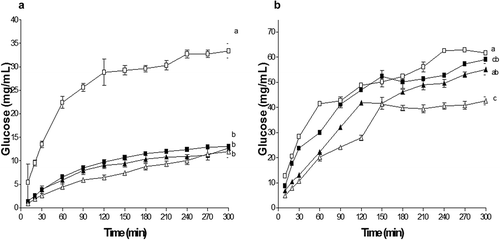
Figure 6. Effect of pulp hydrocolloids (■), seed (▲) and guar gum (∆) on the hydrolysis of starch (□) using α-amylases. The results represent the mean ± standard deviation of three determinations followed by the same letters do not differ by the Tukey test (p > 0.05).
Figura 6. Efecto de los hidrocoloides de pulpa (■), semilla (▲) y goma guar (∆) sobre la hidrolisis del almidón (□) usando α-amilasas. Los resultados representan la media ± desviación estándar de tres determinaciones. Valores con la misma letra no son diferentes estadísticamente de acuerdo a la prueba de Tukey (p > 0.05).
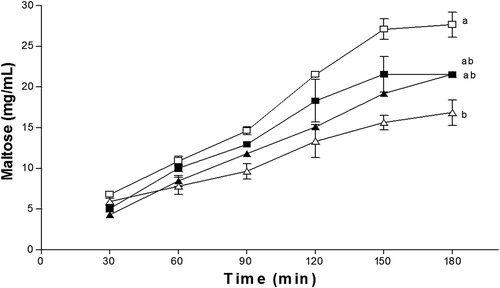
Figure 7. Rotational steady flow measurements of viscosity η as a function of shear rate γ (s1) of hydrocolloid pulp and of hydrocolloid seed at concentrations of 0.5 (●), 1.0 (о), 1.5 (▼) and 2 (Δ) % (w/v). As controls used guar gum 1% (■).
Figura 7. Mediciones de viscosidad η en estado estacionario en función de la velocidad de cizalla, γ (s1) de hidrocoloide de pulpa y semilla a concentraciones de 0.5 (●), 1.0 (о), 1.5 (▼) y 2 (Δ) % (w/v). Goma guar a 1% fue utilizada como control (■).
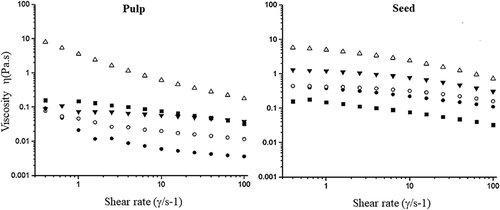
Figure 8. Oscillatory measurements G’ (●) and G’’ (о) as a function of the frequency ω (rad s−1) of the hydrocolloid seed (SH) at concentrations of 0.5% (a), 1% (b), 1.5% (c) and 2% (d). As controls used guar gum 1% (b) (▼).
Figura 8. Mediciones oscilatorias de G’ (●) y G’’ (ο) en función de la frecuencia ω (rad s−1) de hidrocoloide de semilla (SH) a concentraciones de 0.5% (a), 1% (b), 1.5% (c) y 2% (d). Goma guar a 1% (b) (▼) fue utilizada como control.
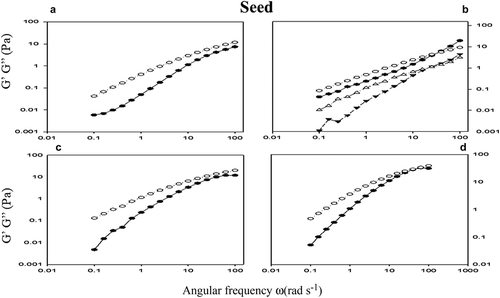
Figure 9. Oscillatory measurements G’ (●) and G’’ (о) as a function of the frequency ω (rad s−1) of the hydrocolloid pulp (PH) at concentrations of 0.5% (a), 1% (b), 1.5% (c) and 2% (d). As controls used guar gum 1% (b) (▼).
Figura 9. Mediciones oscilatorias de G’ (●) y G’’ (ο) en función de la frecuencia ω (rad s−1) de hidrocoloide de pulpa (PH) a concentraciones de 0.5% (a), 1% (b), 1.5% (c) y 2% (d). Goma guar a 1% (b) (▼) fue utilizada como control.
